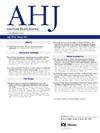Design, rationale, and characterization of the mobile health based occupational cardiovascular risk intervention study (mHealth-OPEN study)
IF 3.7
2区 医学
Q1 CARDIAC & CARDIOVASCULAR SYSTEMS
引用次数: 0
Abstract
Background
The substantial workforce and suboptimal cardiovascular health highlights the urgent need for workplace interventions. This ongoing cluster-randomized trial aims to evaluate the effectiveness, feasibility, and acceptability of a mobile health (mHealth) based comprehensive intervention program to improve cardiovascular health among employees.
Methods and results
We conducted a 1-year, 2-arm, parallel-group, cluster-randomized controlled multicenter trial involving 10,000 participants (aged 18-65, including 1,600 participants with high cardiovascular risk) across 20 workplaces. Workplaces were randomly assigned in a 1:1 ratio to either the intervention or control group. We established a mHealth based multifaceted cardiovascular risk management system that enables intelligent management. The intervention groups received a mHealth-based management with primary prevention inventions for all participants and additional cardiovascular risk interventions for participants with high cardiovascular risk via the system. The control groups received usual care. Primary outcomes included percentage changes in hypertension, diabetes, and dyslipidemia control rates among participants with high cardiovascular risk, and percentage changes in the rate of regular physical activity among all the participants, from baseline to 12-month follow-up. Secondary outcomes included changes in blood pressure, glucose, lipid, treatment adherence, behavioral factors, questionnaire scores, and incidence of major cardiovascular events. By now, baseline recruitment has been completed, with comparable characteristics between management and control groups.
Conclusions
This rigorous designed mHealth-based workplace intervention demonstrates potential for nationwide implementation, offering cardiovascular benefits for employees.
Clinical trial registration
www.chictr.org.cn. Identifier: ChiCTR2200066196.
求助全文
约1分钟内获得全文
求助全文
来源期刊

American heart journal
医学-心血管系统
CiteScore
8.20
自引率
2.10%
发文量
214
审稿时长
38 days
期刊介绍:
The American Heart Journal will consider for publication suitable articles on topics pertaining to the broad discipline of cardiovascular disease. Our goal is to provide the reader primary investigation, scholarly review, and opinion concerning the practice of cardiovascular medicine. We especially encourage submission of 3 types of reports that are not frequently seen in cardiovascular journals: negative clinical studies, reports on study designs, and studies involving the organization of medical care. The Journal does not accept individual case reports or original articles involving bench laboratory or animal research.
 求助内容:
求助内容: 应助结果提醒方式:
应助结果提醒方式:


